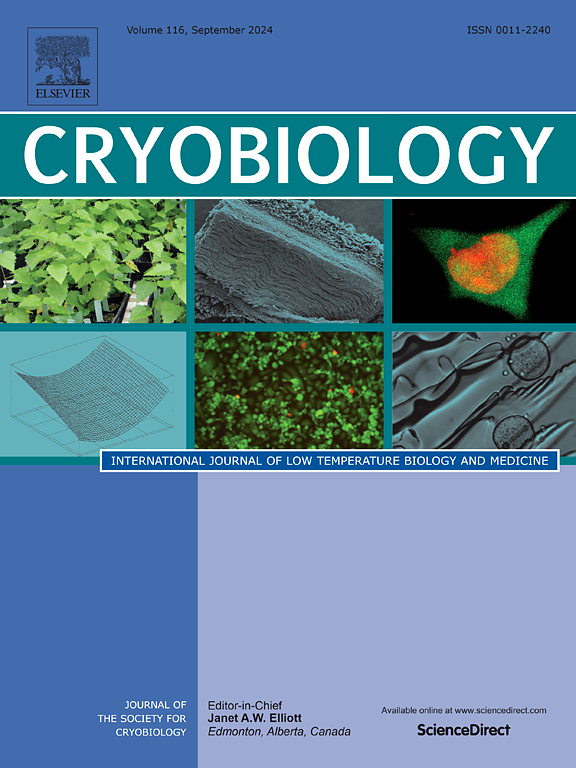虾青素在小鼠精原干细胞低温保存中的抗氧化能力和保护能力
IF 2.3
3区 生物学
Q2 BIOLOGY
引用次数: 0
摘要
精原干细胞(SSCs)的低温保存提供了一些好处,但它也可能导致各种形式的损伤,可能会降低这些细胞的功能。在低温保存培养基中加入抗氧化剂可以通过降低活性氧(ROS)的水平来防止低温保存的有害影响。本研究通过评价虾青素(astaxanthin, AST)对新生雄性小鼠睾丸ssc的保护作用,建立最佳冷冻保存方法。将AST以1 μM、10 μM和100 μM的浓度加入到冷冻基础培养基中,并与对照(不添加任何添加剂)和100 μM维生素E作为常规抗氧化剂进行比较。在培养和纯化3周后,在冻融的ssc中测定活力、氧化应激状态、细胞内ROS生成水平以及Bax和Bcl2的表达。结果表明,在冷冻介质中加入抗氧化剂,特别是10 μM AST,可显著提高细胞活力和总抗氧化能力(TAC) (P <;0.05),并降低了冻融scs的脂质过氧化水平和细胞内ROS积累。维生素E、10 μM和100 μM AST通过下调Bax和上调Bcl2来减少小鼠ssc的凋亡。本研究结果表明,在冷冻介质中加入10 μM的AST对解冻后的ssc具有保护作用。因此,在低温保存培养基中加入10 μM AST可显著提高ssc解冻后的存活能力和抗氧化能力。这些结果表明,AST可以作为一种有价值的添加剂来改善ssc的冷冻保存过程,从而为保存男性生育能力提供潜在的好处。本文章由计算机程序翻译,如有差异,请以英文原文为准。
The antioxidant capacity and protective ability of astaxanthin in cryopreservation of mouse spermatogonial stem cells
Cryopreservation of spermatogonial stem cells (SSCs) offers several benefits, but it can also cause various forms of damage that may reduce the functionality of these cells. Incorporating antioxidants into the cryopreservation medium can provide protection against the detrimental effects of cryopreservation by reducing levels of reactive oxygen species (ROS). In this study, the protective effect of astaxanthin (AST) was evaluated to establish an optimal cryopreservation method for SSCs obtained from the testes of neonatal male mice. AST was added to the freezing base medium at 1, 10, and 100 μM concentrations, and then compared with the control (freezing medium without any additives) and 100 μM vitamin E as a conventional antioxidant. Viability, oxidative stress status, intracellular ROS generation levels, and the expression of Bax and Bcl2 were measured in frozen-thawed SSCs 3 weeks after culture and purification. The data showed that the presence of antioxidants, especially 10 μM AST, in the freezing medium significantly increases the viability and total antioxidant capacity (TAC) (P < 0.05), and reduces the levels of lipid peroxidation and intracellular ROS accumulation in the frozen–thawed SSCs. Vitamin E, as well as 10 and 100 μM AST reduced apoptosis in mouse SSCs by downregulating Bax and upregulating Bcl2. The results of this study suggest that adding 10 μM of AST to the freezing medium provides protection to SSCs after thawing. Therefore, the inclusion of 10 μM AST in the cryopreservation medium significantly improves the post-thaw viability and antioxidant capacity of SSCs. These findings indicate that AST could serve as a valuable additive for improving the cryopreservation process of SSCs, thereby offering potential benefits for the preservation of male fertility.
求助全文
通过发布文献求助,成功后即可免费获取论文全文。
去求助
来源期刊

Cryobiology
生物-生理学
CiteScore
5.40
自引率
7.40%
发文量
71
审稿时长
56 days
期刊介绍:
Cryobiology: International Journal of Low Temperature Biology and Medicine publishes research articles on all aspects of low temperature biology and medicine.
Research Areas include:
• Cryoprotective additives and their pharmacological actions
• Cryosurgery
• Freeze-drying
• Freezing
• Frost hardiness in plants
• Hibernation
• Hypothermia
• Medical applications of reduced temperature
• Perfusion of organs
• All pertinent methodologies
Cryobiology is the official journal of the Society for Cryobiology.
 求助内容:
求助内容: 应助结果提醒方式:
应助结果提醒方式:


